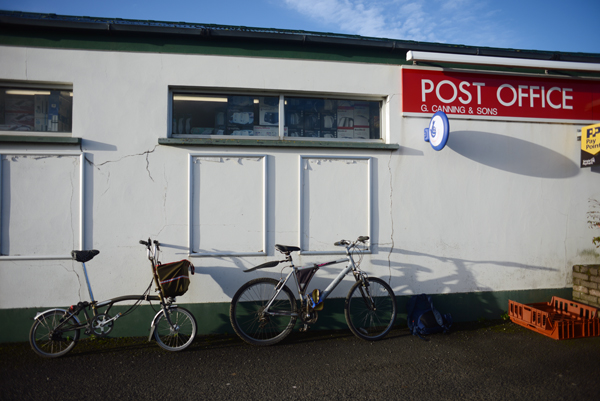
What makes the mountain bike immediately appealing to me as a hop on and go bicycle, is the combination of positioning and stepover height. The straight handlebars allow for a sportily upright posture. And most MTB frames today have sloping top tubes, some so dramatic as to out-slope a typical mixte frame. These features make the bike easy to ride casually in my street clothes - including skirts, dresses and long coats.
Then there is the usefulness and stability of the wide knobby tires, making poor road conditions a non-issue. They are great for cycling over potholes, mud, debris, sand, even winter slush and snow and occasional ice. The tires can also open up commuting options, making it possible to cut through forest trails and across fields. Finally, fat tires mean that regardless of frame material and other factors, the bike is unlikely to have a harsh ride quality (a suspension fork, if present, will further contribute to this).
The super-low gearing that comes standard on typical mountain bikes is a godsent for traveling through hilly areas. Even the steepest mountain roads can be tackled in comfort with a sub 1:1 gear.
The 26" wheels address my dislike of toe overlap, even with wide tires.
The disk brakes commonly found on most modern mountain bikes offer excellent braking power in all weather conditions.
Finally, mountain bike frames today are typically made of aluminum, which makes them resistant to rust in wet climates and salty road conditions.
All of these features may not make for the prettiest of bikes, but from the standpoint of sheer practicality they are attractive. And in addition, I find the sporty handling and playful feel of a decent mountain bike quite fun.
As far as drawbacks, the obvious ones are the missing fenders and racks. Cycling in the rain or after the rain quickly turns street clothes into a mess. And there is no convenient way to carry things on the bike. Of course both fenders and racks can usually be retrofitted. But this introduces extra costs, complexity, and compatibility issues. And on a borrowed bike doing so if not really feasible. All of this also applies to lighting, for those who prefer the convenience and security of dynamo lights.
Gripping the straight handlebars can also feel uncomfortable over longer distances, and while handlebars can be changed this again introduces extra work, cost, etc.
Otherwise, the one thing I am not crazy about is the high bottom bracket typical of mountain bike frames, preferring a low bottom bracket instead. This, however, is not a dealbreaker, just a personal preference.
All in all, I feel that a decent quality mountain bike, if properly accessorised, can make for a comfortable, practical, versatile and fun transportation/ utility bicycle. And while there do exist readily available bikes on the market (under the "hybrid" category) that appear to already accomplish this, in the past I've disliked the ones I've tried - consistently finding them uncomfortable and inefficient. Recently I tried a few once again, in an attempt to understand what it was about them I disliked. And the thing is, while some of these commuter-ready bikes may superficially resemble mountain bikes, with their fat knobby tires, suspension forks, and general aesthetic, the geometry and handling feel off. I am guessing the manufacturers alter traditional MTB designs to accomplish a more upright position and cruiser-like handling, in the process ending up with a bike that's really neither here nor there.
Despite the recent increase in dedicated transportation bicycles of all stripes, I think the mountain bike, with some modifications, remains a good off-the-shelf option, especially for those with hilly commutes and mixed terrain possibilities, who nonetheless want to dress in street clothes and sit upright. And why not? The more options the merrier.




0 comments:
Post a Comment